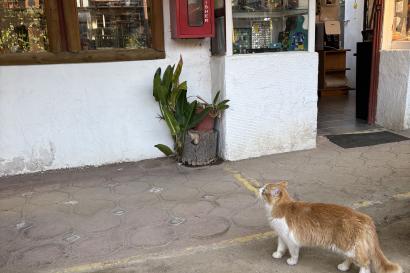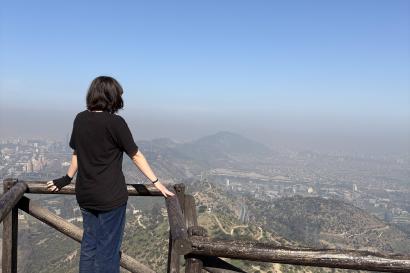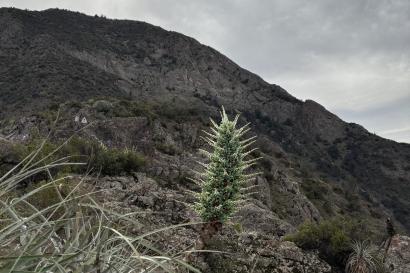After a 3:45 AM departure Friday morning, we emerged bleary-eyed from the airport in Puerto Montt. Outside the air was brisk and our director Maricarmen donned a full-length parka; the climate in the Lake District is vastly different from that of Santiago. We got on a bus and drove to board a ferry. The trip out to the island of Chiloé was picturesque, with apparently unusually clear skies. After arriving on the island, we stopped on the side of the road at a small group of tents. We ordered cheese and shrimp empanadas and coffee, wandering through the stands to explore the plentiful offerings of seafood. One of the vendors cracked open a sea urchin and gave it to the cat weaving around us, and another crouched by the water, pulling in nets full of mussels and wriggling fish.
From Ancud, we went to a pristine beach for a boat tour, a personal highlight of the trip. The sailors wheeled us out on a wooden platform, chuckling at our unsteadiness (don’t get the gringos wet!) and depositing us safe and dry on the boat above the chilly water. On the boat, we navigated around small islands teeming with birds and penguins. Because of the archipelago’s cold currents and proximity to Antarctica, both Magellanic and Humboldt penguins are found on its shores. That night, we stayed in the town of Castro in colorful palafitos, houses built on stilts along the coast. Before dinner, we went on a walk and stepped into a jewelry shop. After a quick conversation with the shop owner, we realized her son, who goes to school in Santiago, lives with someone on our program! We all took a picture with her and sent it to him. I was told that the residents of southern Chile in particular are generally very welcoming and eager to share their place and culture with visitors. Everyone I spoke with seemed genuinely interested to hear where I was from, my impressions of Chile so far, where I had traveled, where I planned to travel…
We ate dinner up on the deck of one of the palafitos, tapas-style with ceviche, empanadas, baked desserts, and of course a honey-infused pisco sour. We watched the sun set and then remained for hours, chatting with our guide, the employees of the hotel, and each other. Three of us particularly committed to ACC basketball were able to find the Carolina-Duke game and stream it from the hostel computer, making a Chilean friend in the process who came to watch with us, amused by our intensity. It was a funny mix of cultures, watching Carolina basketball and making small talk in Spanish in a little hostel off the coast of Chile, and I felt simultaneously connected to and extremely far away from my world in the United States.
A walk along the beach brought us to a small farm run by a single woman who grew almost a dozen types of potatoes, garlic, and beautiful produce in a greenhouse overlooking the ocean. We ate lunch at another farm, where the farmer and his wife have become somewhat famous for their sustainable model and their sweet story. The farmer called the Great Pyrenees guard dogs over by mimicking the noise of an injured sheep, and then with a single sound and hand gesture signaled for the sheepdog to guide the herd over to us. We met his llamas and horses, and then he led us on a walk through a dense old forest with vines and moss growing into each other and species only seen on Chiloé. He showed us the trees he uses when he feels sick or tired (he has never been to a doctor, he told us), and the tree used for chemical warfare against the Spanish that produces a substance similar to tear gas.
Our second night, we stayed in an idyllic palafito in Cucao, a tiny town in Chonchi, with a deck running along the water, a yellow lab named Rompón, and what we agreed was the best salmon we have ever tasted. From there, the next morning we were guided on a hike in the Parque Nacional Chiloe. The landscape changed dramatically during the hike, from fields with sparse trees to dense forests studded with colorful flowers—it felt almost tropical. We were caught in a brief but intense rainstorm right as we came out to the coast, but after were able to lie out to dry back on the deck of the palafito as our guide grilled lunch.
On our way out, we stopped to learn about the distillation of licor de oro (liquor of gold), a traditional yellow liquor made in Chiloé out of milk, sugar, and lemon. We also stopped by a bright yellow Jesuit church in the middle of town, with an entirely wooden interior, and a market overflowing with handmade wool sweaters and wooden crafts. Our stomachs and suitcases full, we made our way back to the ferry, sitting on the top deck as the sun set over the island behind us, and hours later landed back in Santiago.

Thea Lance
<p class="MsoBodyText" style="margin-top:.4pt; margin-right:20.75pt; margin-bottom:.0001pt; margin-left:5.5pt"><span style="line-height:103%">I'm a lover of adventure, whether that's climbing mountains or exploring a new city. This has taken me from my hometown in North Carolina to the arctic circle and beyond, and most recently to Chile! I'm majoring in Biology on a pre-medical track, and I am thrilled to be learning medical Spanish in Santiago this semester.</span></p>








